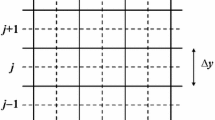Abstract
The planetary geostrophic equations with inviscid balance equation are reformulated in an alternate form, and a fourth-order finite difference numerical method of solution is proposed and analyzed in this article. In the reformulation, there is only one prognostic equation for the temperature field and the velocity field is statically determined by the planetary geostrophic balance combined with the incompressibility condition. The key observation is that all the velocity profiles can be explicitly determined by the temperature gradient, by utilizing the special form of the Coriolis parameter. This brings convenience and efficiency in the numerical study. In the fourth-order scheme, the temperature is dynamically updated at the regular numerical grid by long-stencil approximation, along with a one-sided extrapolation near the boundary. The velocity variables are recovered by special solvers on the 3-D staggered grid. Furthermore, it is shown that the numerical velocity field is divergence-free at the discrete level in a suitable sense. Fourth order convergence is proven under mild regularity requirements.
Similar content being viewed by others
References
Anderson C., Reider M. (1996). A high order explicit method for the computation of flow about a circular cylinder. J. Comput. Phys. 125: 207–224
Cao C.-S., Titi E. (2003). Global well-posedness and finite-dimensional global attractor for a 3-D planetary geostrophic viscous model. Commun. Pure Appl. Math. 56: 198–233
Charney J.G. (1947). The dynamics of long waves in a baraclinic westerly current. J. Meteorol. 47: 135–163
Colin de Verdiere A. (1986). On mean flow instabilities within the planetary geostrophic equations. J. Phys. Oceanogr. 16: 1981–1984
Dukowicz J., Smith R., Malone R. (1993). A reformulation and implementation of the bryan-cox-semtner ocean model on the connection machine. J. Atmos. Ocean. Technol. 10: 195–208
E W., Liu J.-G. (1996). Essentially compact schemes for unsteady viscous incompressible flows. J. Comput. Phys. 126: 122–138
Harlow F.H., Welch J.E. (1965). Numerical calculation of time-dependent viscous incompressible flow of fluid with free surface. Phys. Fluids 8: 2182–2189
Henshaw W., Kreiss H., Reyna L. (1994). A fourth-order accurate difference approximation for the incompressible Navier–Stokes equations. Comput. Fluids 23: 575–593
Lions J.L., Temam R., Wang S. (1992). New formulations of the primitive equations of the atmosphere and applications. Nonlinearity 5: 237–288
Liu J.-G., Samelson R., Wang C. (2006). Global weak solution of planetary geostrophic equations with inviscid geostrophic balance. Appl. Anal. 85: 593–606
Liu J.-G., Wang C., Johnston H. (2003). A fourth order scheme for incompressible Boussinesq equations. J. Sci. Comput. 18(2): 253–285
Liu J.-G., Wang W.-C. (2001). An energy-preserving MAC-Yee scheme for the incompressible MHD equation. J. Comput. Phys. 174: 12–37
Pedlosky J. (1984). The equations for geostrophic motion in the ocean. J. Phys. Oceanogr. 14: 448–455
Pedlosky J. (1987). Geophysical Fluid Dynamics, 2nd edn. Springer, New York
Phillips N.A. (1963). Geostrophic motion. Rev. Geophys. 1: 123–176
Robinson A., Stommel H. (1959). The oceanic thermocline and associated thermohaline circulation. Tellus 11: 295–308
Salmon R. (1990). The thermocline as an “internal boundary layer”. J. Mar. Res. 48: 437–469
Samelson R., Temam R., Wang C., Wang S. (2003). Surface pressure Poisson equation formulation of the primitive equations: Numerical schemes. SIAM J. Numer. Anal. 41: 1163–1194
Samelson R., Temam R., Wang S. (1998). Some mathematical properties of the planetary geostrophic equations for large scale ocean circulation. Appl. Anal. 70: 147–173
Samelson R., Temam R., Wang S. (2000). Remarks on the planetary geostrophic model of grye scale ocean circulation. Differ. Integral Equ. 13: 1–14
Samelson R., Vallis G. (1997). A simple friction and diffusion scheme for planetary geostrophic basin models. J. Phys. Oceanogr. 27: 186–194
Smith R., Dukowicz J., Malone R. (1992). Parallel ocean general circulation modeling. Phys. D 60: 38–61
Stommel H., Webster J. (1962). Some properties of the thermocline equations in a subtropical gyre. J. Mar. Res. 44: 695–711
Temam R. (1984). Navier–Stokes Equations: Theory and Numerical Analysis. North-Holland, Amsterdam
Wang, C.: The primitive equations formulated in mean vorticity, Discrete and Continuous Dynamical Systems. In: Proceedings of International Conference on Dynamical Systems and Differential Equations, pp. 880–887 (2003)
Wang C. (2004). Convergence analysis of the numerical method for the primitive equations formulated in mean vorticity on a Cartesian grid. Discret. Contin. Dynam. Syst. Ser. B 4: 1143–1172
Wang C., Liu J.-G. (2002). Analysis of finite difference schemes for unsteady Navier–Stokes equations in vorticity formulation. Numer. Math. 91: 543–576
Wang C., Liu J.-G., Johnston H. (2004). Analysis of a fourth order finite difference method for incompressible Boussinesq equations. Numer. Math. 97: 555–594
Welander P. (1959). An advective model of the ocean thermocline. Tellus 11: 309–318
Author information
Authors and Affiliations
Corresponding author
Additional information
R. Samelson was supported by NSF grant OCE04-24516 and Navy ONR grant N00014-05-1-0891.
R. Temam was supported by NSF grant DMS-0604235 and the research fund of Indiana University.
S. Wang was supported by NSF grant DMS-0605067 and Navy ONR grant N00014-05-1-0218.
Rights and permissions
About this article
Cite this article
Samelson, R., Temam, R., Wang, C. et al. A fourth-order numerical method for the planetary geostrophic equations with inviscid geostrophic balance. Numer. Math. 107, 669–705 (2007). https://doi.org/10.1007/s00211-007-0104-z
Received:
Published:
Issue Date:
DOI: https://doi.org/10.1007/s00211-007-0104-z



